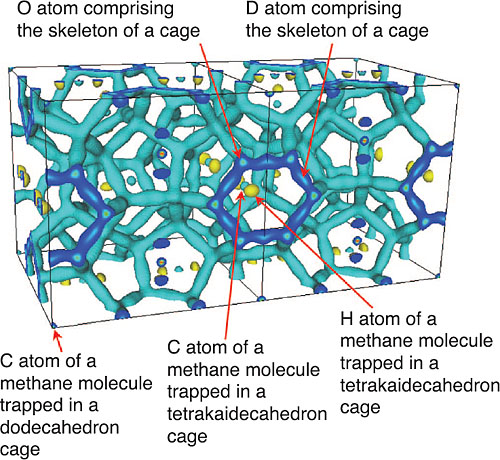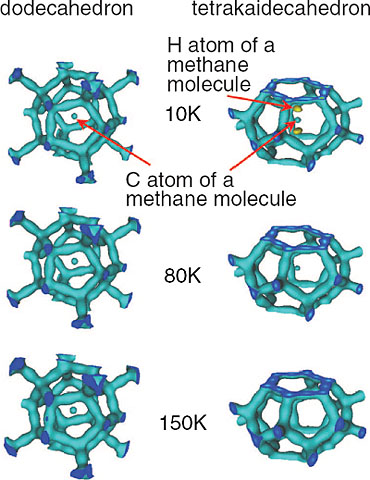Methane hydrate is a solid-state substance and consists of two types of cages (large and small cages) formed by water molecules. A methane molecule is trapped inside each cage. Therefore, it is called "burning ice." Since this material is deposited in the seafloor and the deposits are estimated to exceed those of natural gas, it has attracted great interest as an energy resource to replace natural gas. Understanding the physical proprieties, such as the temperature dependence of the crystal structure, helps to specify the optimum environmental temperature and pressure during drilling, transport, and storage of methane hydrate.
Methane hydrate consists of hydrogen (H), carbon (C), and oxygen (O) atoms, which are all light elements that can be examined most appropriately utilizing neutrons. The neutron sensitivities, called the neutron scattering lengths, of H and deuterium (D) are very different. Thus, we can distinguish H and D using the neutron scattering method. Therefore, we substituted D for the H in water to distinguish the H of methane from that in water. Accordingly, we successfully synthesized single-phase methane hydrate free of impurities by optimizing the synthesis temperature and methane gas pressure using fine and uniform sizes of ice particles. This allowed a unique and invaluable investigation of the structural analyses in the temperature range of 10 to 180K, which is just below its decomposition temperature, using a high-resolution powder diffractomer, HRPD, on the neutron beamlime of the JRR-3 reactor. Analyzing the diffraction patterns using the Rietveld method and maximum entropy method, we successfully visualized, for the first time, the scattering-length density distribution map of methane hydrate, as shown in Fig. 4-9. From the figure, one can see the large and small cages. Temperature dependence of the scattering-length density distribution maps is shown in Fig. 4-10. In this figure, no H of the methane is observed, although C is observed at the center of the dodecahedron cage in the map. This indicates that a methane molecule spins freely around its C atom in the cage. This behavior is independent of temperature. On the other hand, the behavior of methane depends on the temperature in the tetrakaidecahedron cage. The H of methane is attracted to the hexagonal facet of the cage at 10K, and the methane molecule spins freely around its C atom as it does in the dodecahedron cage at 80K. No C atoms were observed in the tetrakaidecahedron cage at 150K, which indicates methane moves inside the cage randomly. These results reveal that the motion of methane molecules differs between the dodecahedron and tetrakaidecahedron cages. |

